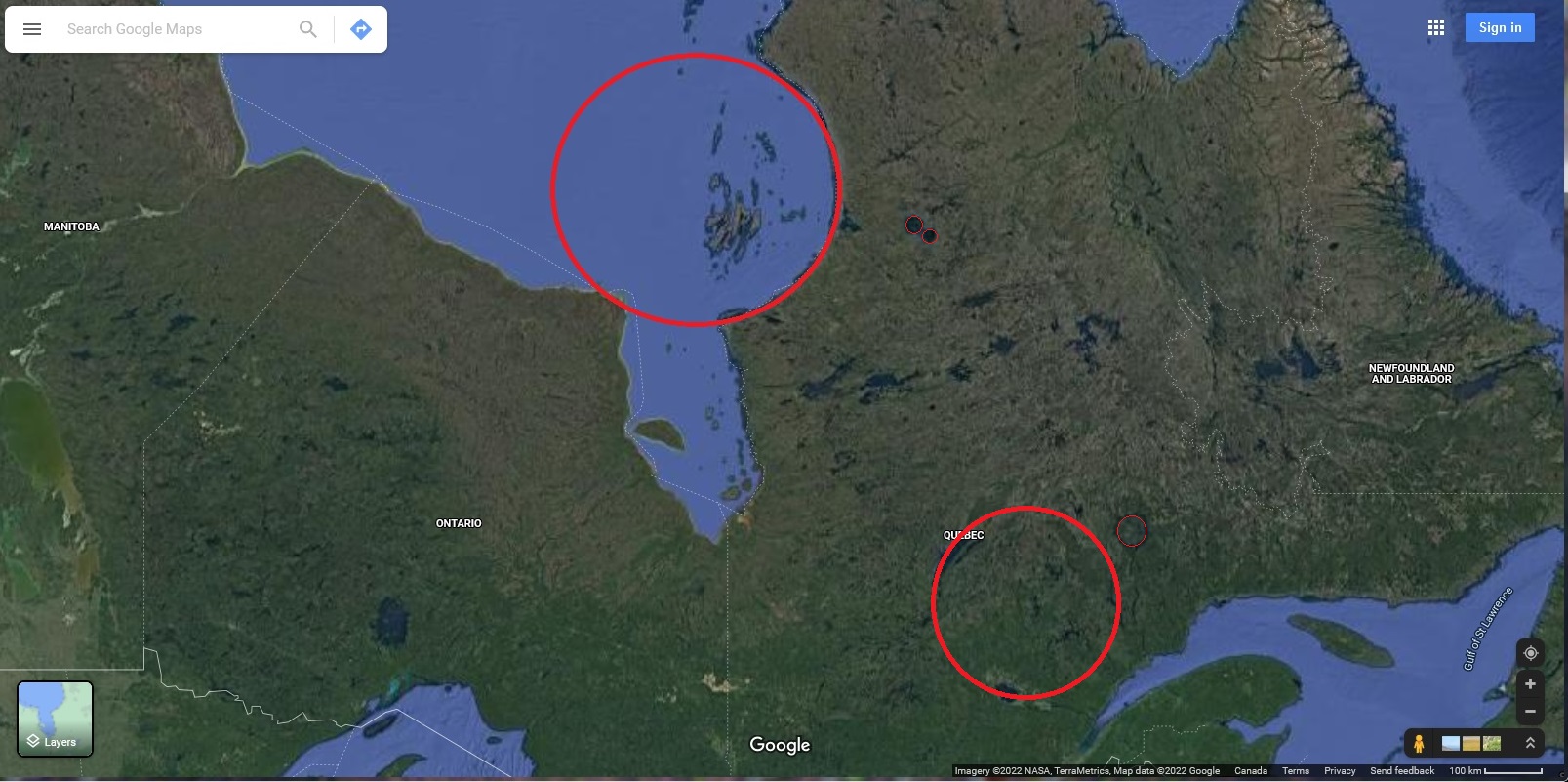It looks like you're using an Ad Blocker.
Please white-list or disable AboveTopSecret.com in your ad-blocking tool.
Thank you.
Some features of ATS will be disabled while you continue to use an ad-blocker.
share:
Good evening ladies and gentlemen, John SkieSwanne here, I hope everyone is having a nice evening.
I might have accidentally discovered a crater.
I have checked with many, many geological maps, and so far I haven't seen that crater registered anywhere yet, which leads me to believe I may be the first to have noticed it. Shortening my name as I usually do for scientific discoveries (such as the Swanne preons), I therefore will be naming this potential crater the Swanne Crater, if others confirm the discovery.
I discovered it by pure accident. On January the 15th I was browsing weather infrared satellite images of Quebec, where I live in. Normally I use the IR images to predict how cold it'll get up here and see how much wood I'll need to chop for the day. So, at one point, and this happens in only one picture frame, the sun begins to rise at the East. At this single moment, the Sun illuminates the highest points and only the highest points, making them slightly warmer, while the lower lands remain cool. In those unique conditions, and using pure IR imagery (as opposed to visible light or microwave), the highlights of what seems to be a very large crater therefore appeared. The moment lasted for a single frame, I was just very lucky to have noticed it. Before it disappeared for all eternity, I at least had the common sense of screen-capturing the image.
Here's the image (original first, then highlight of what appears to be the crater).
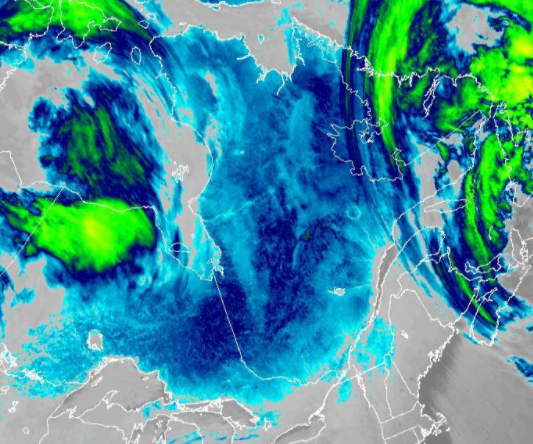
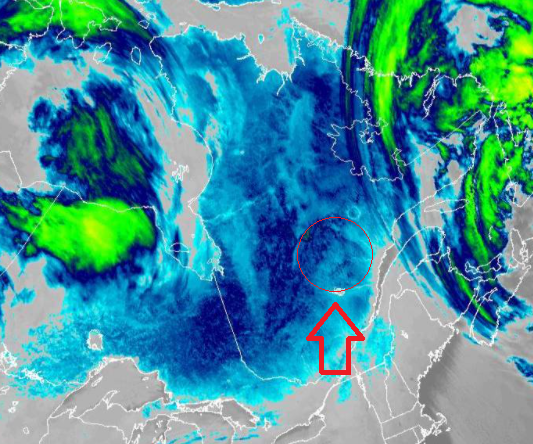
Some of you might have some trouble noticing it in the original picture; it's rather faint and it would certainly explain why no one had noticed it before. Those with good eyes will notice the typical rign associated with craters; and, most of all, that it's NOT a small crater.
If the discovery is confirmed, this would make the crater the largest in the entire world; I calculate its diameter to be about 370 kilometers. It is bordered by the Manicouagan Crater to the North, the Saint-Jean Lake to the South, and the Mistassini Lake at the West. The possible existence of the Swanne Crater could perhaps explain the odd, curved shape of the Mistassini Lake, which seems to mark the very edge of the crater. I am no professional geologist, but I would tend to believe that the crater would be rather old, given that the Manicouagan Crater is not deformed at all despite sitting on the very edge of the impact, and therefore must have occurred AFTER the Swanne Crater. Judging from the IR picture above, I am noticing that quite a bit of erosion appreas to have occurred after the suspected impact, which could indicate that the impact occurred a very, very long time ago; but I realize this might also be glacial erosion from the ice ages, so I remain uncertain of the exact age. I hope a proper geologist could give a better opinion on the matter.
What is certain, is that if confirmed as a crater, the impact would have been a dramatic prehistoric event, given the sheer size of the crater and, by extension, of the impactor. To give you a general idea, the crater of Chicxulub, which is believed to have killed the dinosaurs and a large number of animals, is "only" 150 kilometers across. It would be interesting to see if this ancient crater correlates with any extinction events or changes in climate that were, until now, hard to explain.
So, did we just discover a crater? And if so, are there some resident geologists that could give us an insight into the potential time, impactor size and effects of this prehistorical impact?
I might have accidentally discovered a crater.
I have checked with many, many geological maps, and so far I haven't seen that crater registered anywhere yet, which leads me to believe I may be the first to have noticed it. Shortening my name as I usually do for scientific discoveries (such as the Swanne preons), I therefore will be naming this potential crater the Swanne Crater, if others confirm the discovery.
I discovered it by pure accident. On January the 15th I was browsing weather infrared satellite images of Quebec, where I live in. Normally I use the IR images to predict how cold it'll get up here and see how much wood I'll need to chop for the day. So, at one point, and this happens in only one picture frame, the sun begins to rise at the East. At this single moment, the Sun illuminates the highest points and only the highest points, making them slightly warmer, while the lower lands remain cool. In those unique conditions, and using pure IR imagery (as opposed to visible light or microwave), the highlights of what seems to be a very large crater therefore appeared. The moment lasted for a single frame, I was just very lucky to have noticed it. Before it disappeared for all eternity, I at least had the common sense of screen-capturing the image.
Here's the image (original first, then highlight of what appears to be the crater).


Some of you might have some trouble noticing it in the original picture; it's rather faint and it would certainly explain why no one had noticed it before. Those with good eyes will notice the typical rign associated with craters; and, most of all, that it's NOT a small crater.
If the discovery is confirmed, this would make the crater the largest in the entire world; I calculate its diameter to be about 370 kilometers. It is bordered by the Manicouagan Crater to the North, the Saint-Jean Lake to the South, and the Mistassini Lake at the West. The possible existence of the Swanne Crater could perhaps explain the odd, curved shape of the Mistassini Lake, which seems to mark the very edge of the crater. I am no professional geologist, but I would tend to believe that the crater would be rather old, given that the Manicouagan Crater is not deformed at all despite sitting on the very edge of the impact, and therefore must have occurred AFTER the Swanne Crater. Judging from the IR picture above, I am noticing that quite a bit of erosion appreas to have occurred after the suspected impact, which could indicate that the impact occurred a very, very long time ago; but I realize this might also be glacial erosion from the ice ages, so I remain uncertain of the exact age. I hope a proper geologist could give a better opinion on the matter.
What is certain, is that if confirmed as a crater, the impact would have been a dramatic prehistoric event, given the sheer size of the crater and, by extension, of the impactor. To give you a general idea, the crater of Chicxulub, which is believed to have killed the dinosaurs and a large number of animals, is "only" 150 kilometers across. It would be interesting to see if this ancient crater correlates with any extinction events or changes in climate that were, until now, hard to explain.
So, did we just discover a crater? And if so, are there some resident geologists that could give us an insight into the potential time, impactor size and effects of this prehistorical impact?
a reply to: swanne
Just to clarify, you're not pointing out lac
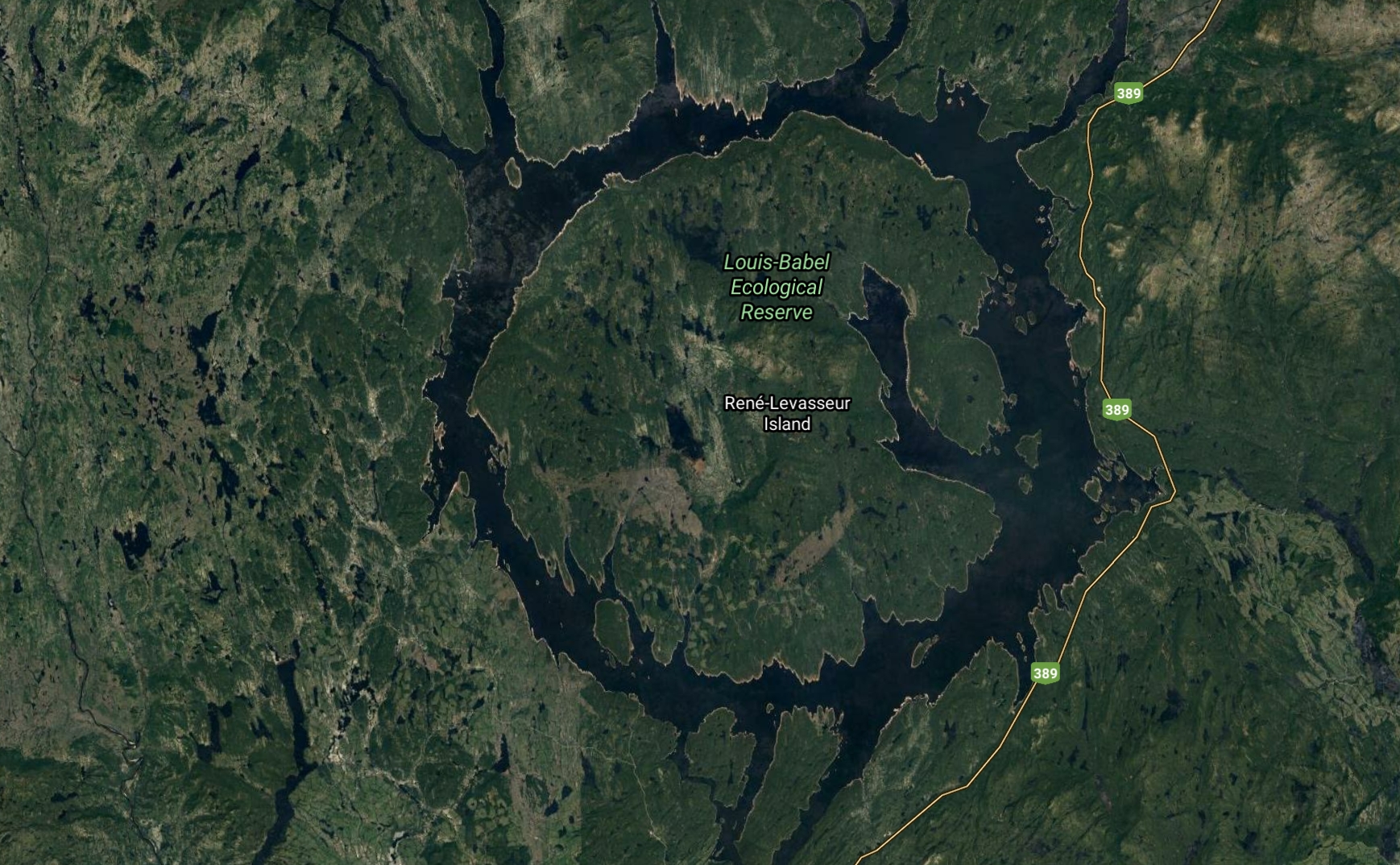
51.2985949, -68.6371218
www.environnement.gouv.qc.ca...
That is a crater that was formed by Meteor Strike.
I can't see exactly where you're pointing to with that map cover.
Edit:
Hmmmmmm.... looking around with interest.
Edit: not this right?
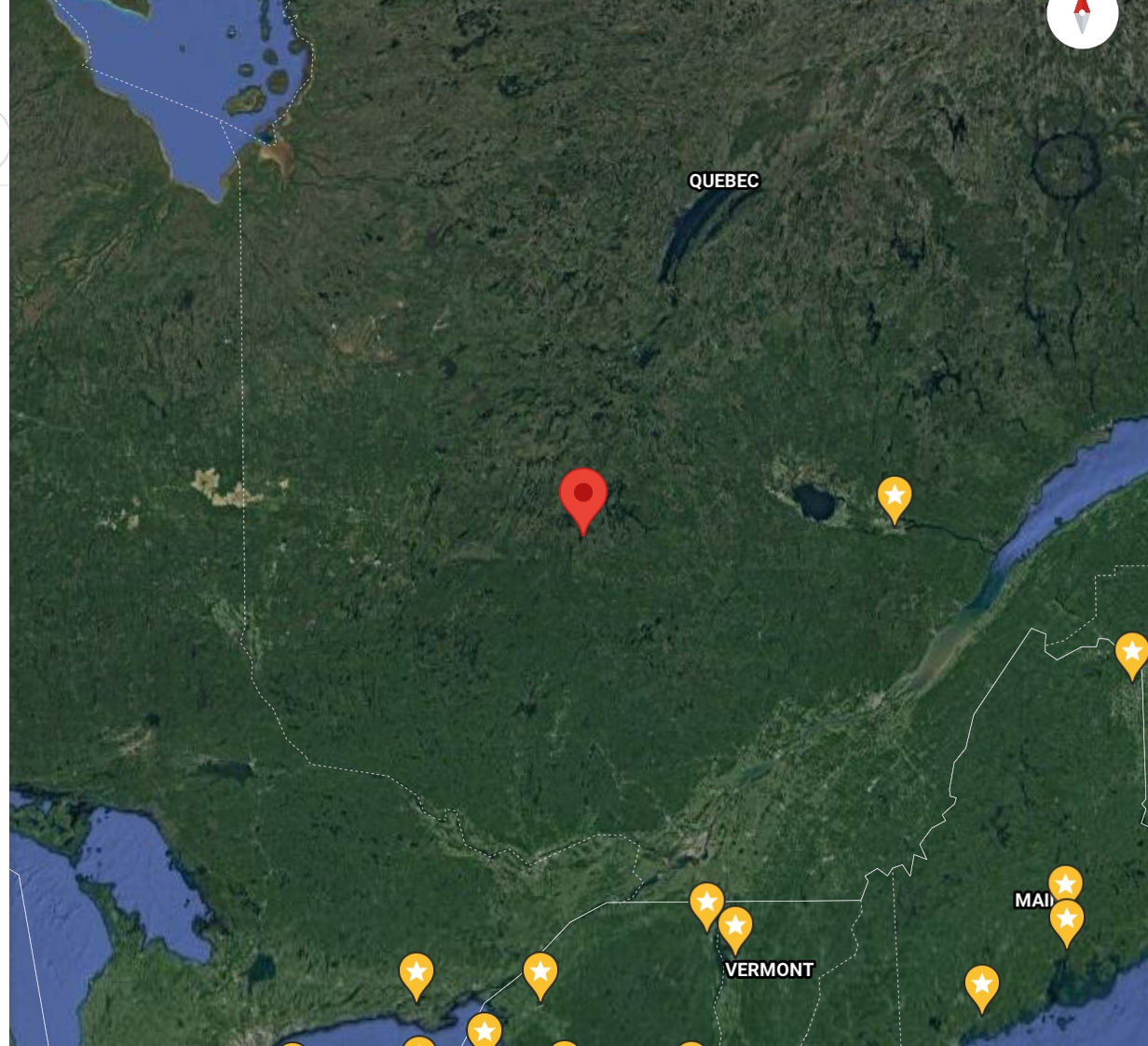
Just to clarify, you're not pointing out lac

51.2985949, -68.6371218
www.environnement.gouv.qc.ca...
That is a crater that was formed by Meteor Strike.
I can't see exactly where you're pointing to with that map cover.
Edit:
by the Manicouagan Crater to the North, the Saint-Jean Lake to the South, and the Mistassini Lake at the West
Hmmmmmm.... looking around with interest.
Edit: not this right?


edit on 21-1-2022 by Bigburgh because: (no reason given)
a reply to: Bigburgh
Nope, that's the Manicouagan Lake, it's sitting on the north of the crater I highlighted.
EDIT:
Nope, neither. I took the liberty of highlighting the potential crater in the second picture, for you guys' convenience.
Using your map, this would be the approximate location (I have to deal with a mercator projection so please be kind about my precision ):
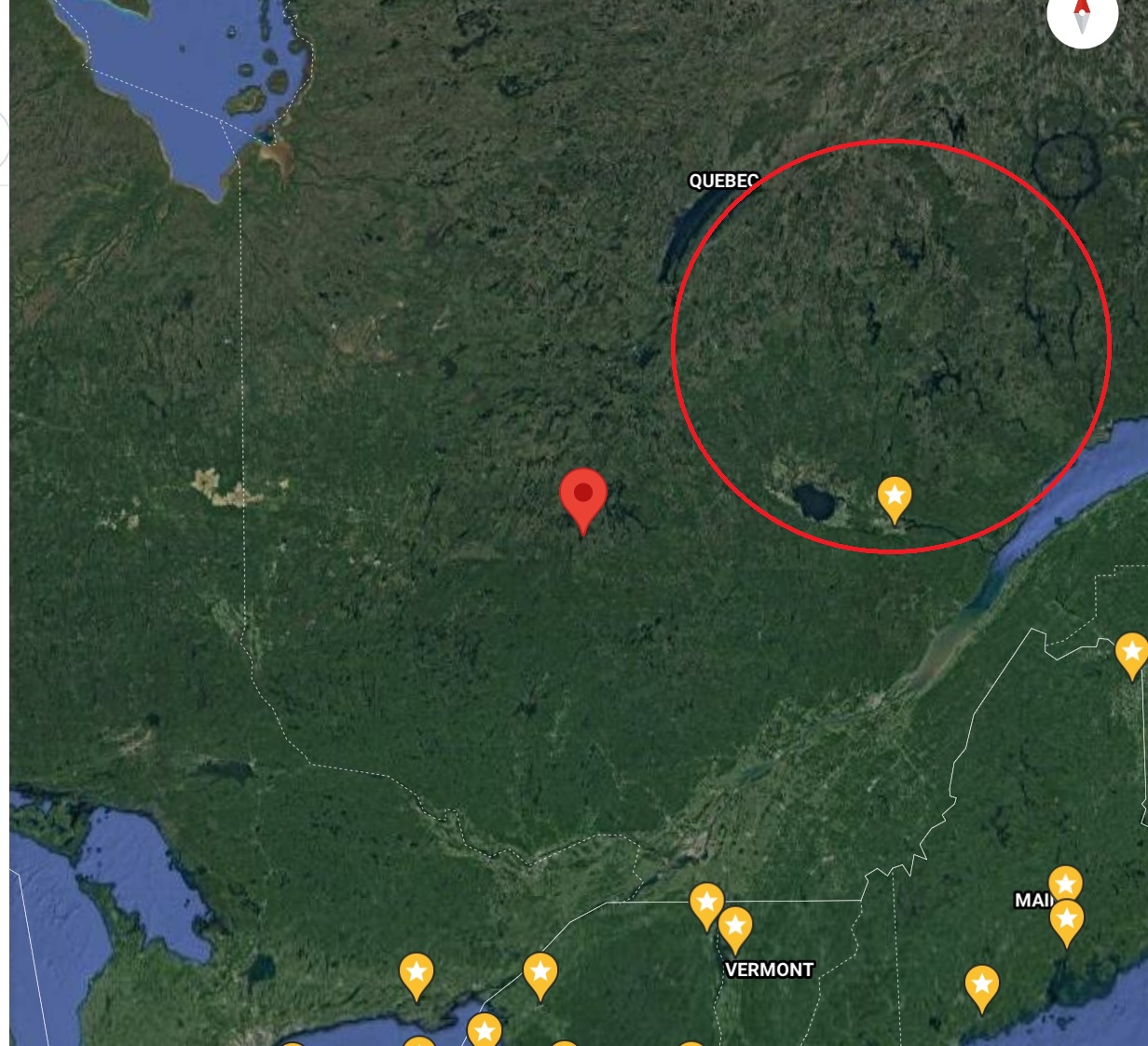
Nope, that's the Manicouagan Lake, it's sitting on the north of the crater I highlighted.
EDIT:
Nope, neither. I took the liberty of highlighting the potential crater in the second picture, for you guys' convenience.
Using your map, this would be the approximate location (I have to deal with a mercator projection so please be kind about my precision ):

edit on 21-1-2022 by swanne because: (no reason given)
That just looks like a circle in the clouds what are the coords ?
originally posted by: Ravenwatcher
That just looks like a circle in the clouds what are the coords ?
How can I give the exact Google coordinates of something that large and that hasn't been discovered yet? It's about 370 km wide...
a reply to: swanne
I don't think the Scientist give a crap anymore I found a huge meteor strike in Antarctica and was told by 2 different colleges that that's not something they are interested in . And this was a huge debris field . I sent screen grabs and coords .
Or care about any other's findings unless they can take credit .
I don't think the Scientist give a crap anymore I found a huge meteor strike in Antarctica and was told by 2 different colleges that that's not something they are interested in . And this was a huge debris field . I sent screen grabs and coords .
Or care about any other's findings unless they can take credit .
edit on 21-1-2022 by Ravenwatcher because: (no reason given)
a reply to: swanne
Oh, I see what you're getting at now.
Wait..Edit: then that looks like 3 strikes side by side...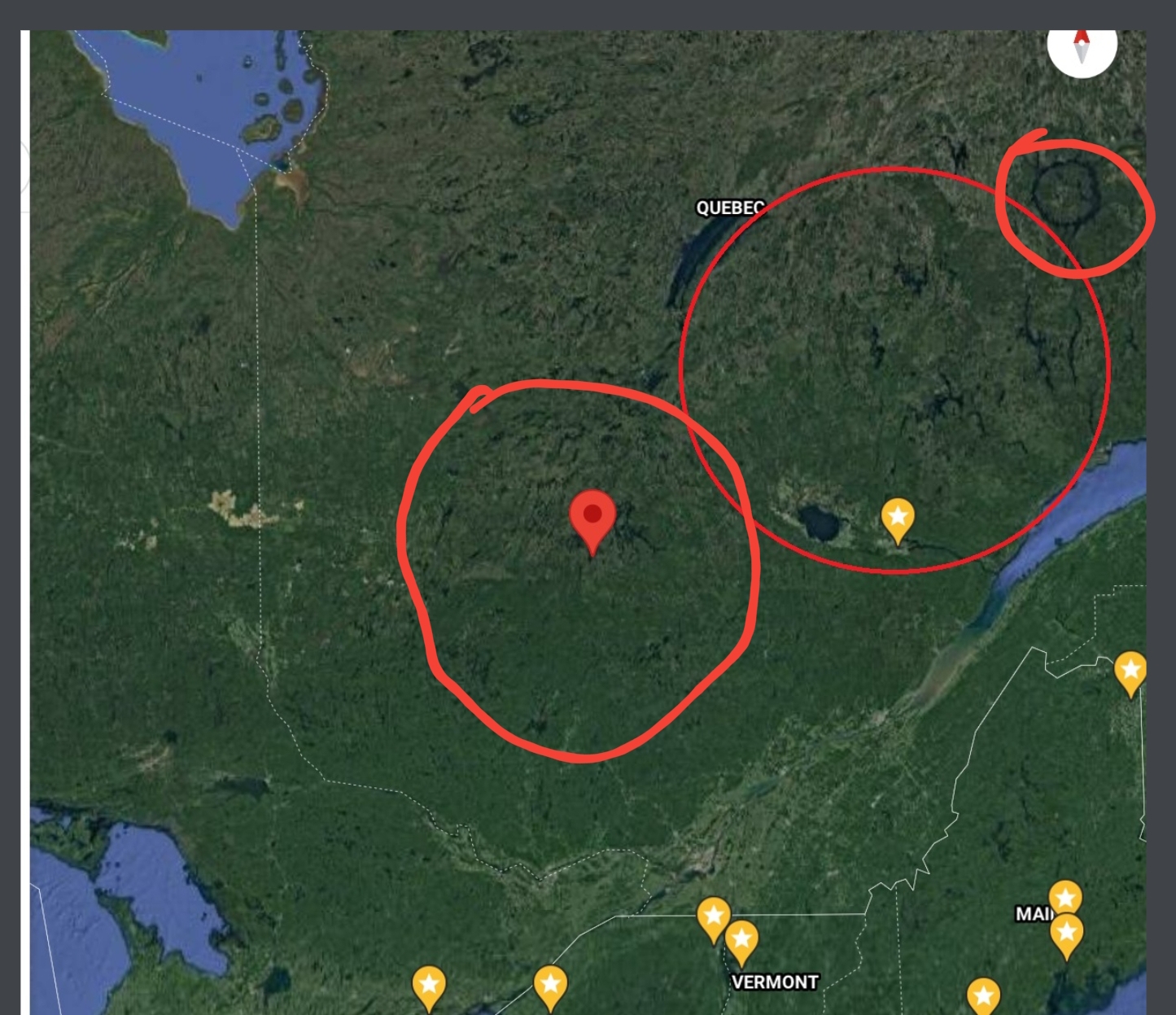
And..
a reply to: PiratesCut
Oh, I see what you're getting at now.
Wait..Edit: then that looks like 3 strikes side by side...

And..
a reply to: PiratesCut
edit on 21-1-2022 by Bigburgh because: (no reason given)
Looking at the center of your circle on Google Earth Pro, you can find a particular set of broken rocks, in the sense they are a different color from
the general surrounding. Part of it is a high point, surounded by a depression and mountain ranges all around.
And this crater would probably be as old as the Earth itself as part of the north of Québec are amongst the oldest emerged landmasses on Earth, even considered to have almost never changed I read once. And it would have been peppered by all the matter that would have been leveled by that hit.
And I agree with bob_uruncle about the Hudson Bay being another major hit.
Nice find, Swanne.
And this crater would probably be as old as the Earth itself as part of the north of Québec are amongst the oldest emerged landmasses on Earth, even considered to have almost never changed I read once. And it would have been peppered by all the matter that would have been leveled by that hit.
And I agree with bob_uruncle about the Hudson Bay being another major hit.
Nice find, Swanne.
edit on 21-1-2022 by coamanach because: (no reason given)
The impacts mentioned in this thread are among the many dealt with in the book Cosmic Cycles of Catastrophe. Yes, it is a book of serious
science, well worth a read.
a reply to: Lazarus Short
Interesting! Does this book give us any information about the potential crater described in the OP?
Interesting! Does this book give us any information about the potential crater described in the OP?
a reply to: Arbitrageur
It also gives us an infrared image of the ground. If the sun is very low, and the sky is clear, it can highlight interesting topological features.
It also gives us an infrared image of the ground. If the sun is very low, and the sky is clear, it can highlight interesting topological features.
Perhaps that area was the initial strike are that led to the
World's Second Largest Impact Crater Was Made by a
Comet just along the same trajectory in to Ontario - Sudbury,
Comet hitting what at the time was supposedly deep water.
Comet hitting what at the time was supposedly deep water.
You would probably need to contact these guys too.
Is the world's biggest crater in Quebec?
Is the world's biggest crater in Quebec?
Still, a team of Quebec geologists believe they have pieced together traces of a 500-kilometer crater in the Chibougamau area, 500 kilometres north of Montreal.
"It will be the biggest crater found on Earth," said Francine Robert. The geologist, who works under Serge Genest at Groupe Omegalpha, said craters of this size can be seen on other planets, so it's reasonable to think an asteroid of this size could have also hit the Earth.
If this is true, please explain the colors and the gray areas in the map. Better yet please provide the source of the data Which you really should have done in the OP), with an explanation of what the colors mean. What does a clear sky look like on this map? Is that where the surface looks gray? In any case, the sky doesn't look clear in the area you highlight, does it?
originally posted by: swanne
a reply to: Arbitrageur
It also gives us an infrared image of the ground. If the sun is very low, and the sky is clear, it can highlight interesting topological features.
Also, if your hypothesis has any validity, you should be able to see some other known large impact craters on weather radar in a similar fashion, right? Have you tried to validate your hypothesis in this way? In fact, aren't there other impact craters on that map area which don't show up?
originally posted by: coamanach
Looking at the center of your circle on Google Earth Pro, you can find a particular set of broken rocks, in the sense they are a different color from the general surrounding. Part of it is a high point, surounded by a depression and mountain ranges all around.
And this crater would probably be as old as the Earth itself as part of the north of Québec are amongst the oldest emerged landmasses on Earth, even considered to have almost never changed I read once. And it would have been peppered by all the matter that would have been leveled by that hit.
And I agree with bob_uruncle about the Hudson Bay being another major hit.
Nice find, Swanne.
It does seem that way; you're right! Nice observation
new topics
-
Say his name
US Political Madness: 41 minutes ago -
There is no such thing as moonlight.
Space Exploration: 1 hours ago -
Breaking: 5 probed after 18-year old girl dies as a result of having the COVID jab
Diseases and Pandemics: 2 hours ago -
Official denial
Diseases and Pandemics: 5 hours ago -
MEGA - Let's Make Europe Great Again
Other Current Events: 5 hours ago -
Hamas and Other Islamist Terrorist Groups Announce Support of US Campus Anti-Israel Protests
Education and Media: 6 hours ago -
Psychotronic Operation Rwanda Who Wants To Be A Refugee?
ATS Skunk Works: 6 hours ago
top topics
-
Breaking: 5 probed after 18-year old girl dies as a result of having the COVID jab
Diseases and Pandemics: 2 hours ago, 9 flags -
Hamas and Other Islamist Terrorist Groups Announce Support of US Campus Anti-Israel Protests
Education and Media: 6 hours ago, 5 flags -
Official denial
Diseases and Pandemics: 5 hours ago, 5 flags -
AI phrenology
Science & Technology: 13 hours ago, 4 flags -
Psychotronic Operation Rwanda Who Wants To Be A Refugee?
ATS Skunk Works: 6 hours ago, 4 flags -
MEGA - Let's Make Europe Great Again
Other Current Events: 5 hours ago, 3 flags -
There is no such thing as moonlight.
Space Exploration: 1 hours ago, 2 flags -
Say his name
US Political Madness: 41 minutes ago, 2 flags
active topics
-
Breaking: 5 probed after 18-year old girl dies as a result of having the COVID jab
Diseases and Pandemics • 12 • : Lochid -
Please share your paranormal & ghost experiences!!
Paranormal Studies • 145 • : Lochid -
Biden "Happy To Debate Trump"
2024 Elections • 71 • : CarlLaFong -
The adventure of publishing books
People • 8 • : DISRAELI2 -
There is no such thing as moonlight.
Space Exploration • 5 • : TheMichiganSwampBuck -
Gov Kristi Noem Shot and Killed "Less Than Worthless Dog" and a 'Smelly Goat
2024 Elections • 93 • : FlyersFan -
Hate makes for strange bedfellows
US Political Madness • 62 • : network dude -
Say his name
US Political Madness • 1 • : DAVID64 -
Thousands Of Young Ukrainian Men Trying To Flee The Country To Avoid Conscription And The War
Other Current Events • 143 • : Xtrozero -
Krystalnacht on today's most elite Universities?
Social Issues and Civil Unrest • 26 • : ToneD

